
-The MOAC Story Part X: Attempting to Improve POW’s Transaction Processing Speed-
In recent years, attempts to improve the processing speed of POW transactions (mostly reflected in POS and DPOS) have moved away from hash collision mining and towards monitoring who has the largest number of native cryptocurrency and a longer time. This approach can probably increase processing speed to over several thousand, about the 2,000–5,000/second level, without sacrificing the advantages of globalization. However, POS and DPOS have shortcomings of their own. POW has been validated by 7 years of implementation when compared with BFT. POS has yet to be tested in large-scale networks.
Ethereum’s new development direction, a POS solution named Casper, appears to need at least 2 years before being fully implemented. And because the transition from POW to POS will involve current community interests, the most likely compromise will be the creation of a two-headed POW+POS. This will make the problem more complicated and make it impossible to solve Ethereum’s speed problem.

..........................................................................................................................................
-The MOAC Story Part XI: MOAC’s Basic Goals-
So MOAC’s basic thought process is to maintain the current public sharing abilities of Bitcoin and Ethereum (allowing them to spread globally) and also fulfill the speed promised by POS. If we did so, we could achieve thousands of transactions per second. So what to do? First, we proposed the concept of a microchain. The parent chain could use Ethereum’s current POW algorithm (using GHOST to resolve differences). This would allow MOAC to spread across the world yet be long-lasting, similar to the Internet. Microchains would utilize the POS algorithm. This has already been proven in small-scale networks. This can provide faster speeds, like how the internet has a VPN virtual network layer built on top of it.
This makes it a layered architecture. Compared to Ethereum’s flat POW+POS architecture, ours is a layered POP (an upper POS layer over a lower POW layer). This way, we can establish tens of thousands of verification nodes across the world and achieve a processing speed of 2,000–5000 transactions/second. Most importantly, this can support microchains, while Ethereum can only support side-chains.

..........................................................................................................................................
The MOAC Story Part XII: The Layering and Sharding of MOAC
If you understand the internet’s TCP/IP architecture, you can understand the layered architecture of MOAC. The upper layer is the SCS (Smart Contract Server). Underneath are the V-nodes (consensus verification nodes). The SCS communicates with peers of the parallel layer, but the data is packaged and connected by the underlying verification machine on the physical layer. This is just like information on a network is packaged according to HTTP, then packaged according TCP, then packaged according to IP and finally packaged by the Ethernet.
However, for logical microchains to be implemented on the physical parent chain, the parent chain has to be capable of splitting. Otherwise, it’s only a single logic microchain and a single physical parent chain. This segmentation is called sharding.



Where to Find Us
Website: https://moac.io/
GitHub: https://github.com/MOACChain/moac-core
Twitter: https://twitter.com/moac_io
Reddit: https://www.reddit.com/r/MOAC/
Medium: https://medium.com/moac
Steemit: https://steemit.com/@moac-official
Telegram(International): https://t.me/moacblockchain
Telegram(Developers): https://t.co/8m3m9RD5ix
Telegram(China): https://t.co/73rU9sHWLH
YouTube (Event Channel):https://www.youtube.com/channel/UCBU405W7vfOPBicLwW9-QOA
Youtube (Technical Channel) :
https://www.youtube.com/channel/UC_U54wsGNrm_Yivj5bH9i7Q?view_as=subscriber
Facebook: https://www.facebook.com/moacchain/